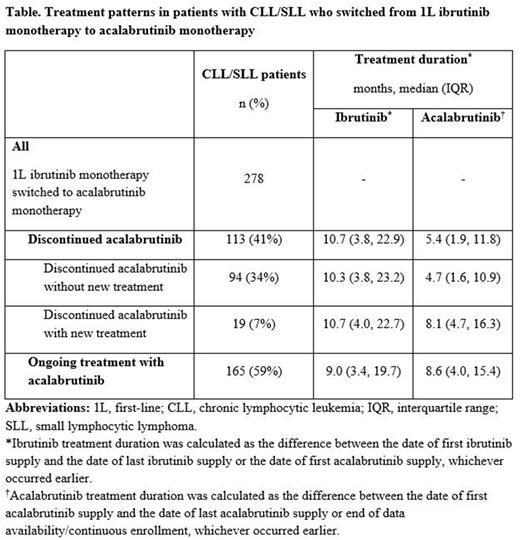Abstract
Introduction: Recent data suggest a shift in treatment of chronic lymphocytic leukemia/small lymphocytic lymphoma (CLL/SLL) towards the use of novel therapies including Bruton tyrosine kinase inhibitors (BTKis). Ibrutinib was the first BTKi which received US Food and Drug Administration (FDA) approval in 2014 for second line treatment for patients with CLL/SLL who received at least one prior therapy and for CLL/SLL with 17p deletion. Ibrutinib was approved as 1st line treatment of these patients in 2016 and has been the main treatment of choice. More recently acalabrutinib was approved by the FDA in 2017 and 2019 for second line and first line treatment, respectively. While BTKi treatment patterns have been evaluated in clinical trials, they are poorly understood in the real-world, especially among patients who switch therapy between BTKis. This study aims to describe the real-world treatment patterns among CLL/SLL patients who switched from first-line (1L) ibrutinib monotherapy to acalabrutinib monotherapy.
Methods: This retrospective cohort study included CLL/SLL patients aged ≥18 years who initiated 1L ibrutinib monotherapy and later switched to acalabrutinib monotherapy, and utilized medical and pharmacy claims data from the Komodo Healthcare Map of insured U.S. patients between January 2015 and April 2022. First-line ibrutinib use was defined as having received no other CLL/SLL treatment during the ≥6 months prior to ibrutinib initiation. Ibrutinib or acalabrutinib monotherapy was defined based on a lack of other CLL/SLL treatment used within a 28-day period. Treatment patterns were assessed during ibrutinib treatment (pre-switch period) and after acalabrutinib initiation (post-switch period), until the earliest of acalabrutinib discontinuation, end of data availability, or end of patient enrollment. Discontinuation of acalabrutinib was defined as a treatment gap of >90 days without re-initiating acalabrutinib during the remaining follow-up. The reason for a within-class treatment switch could not be investigated as claims data do not document treatment-attributable reasons for switching.
Results: We identified 278 CLL/SLL patients who switched from 1L ibrutinib to acalabrutinib monotherapy. At ibrutinib initiation, mean (standard deviation [SD]) age was 66.9 (10.1) years; 42% were female; mean (SD) Quan-Charlson Comorbidity Index score was 2.5 (1.4) points. During a median follow-up of 13 months post-switch, acalabrutinib was discontinued in 113 (41%) patients and ongoing at time of last data availability in 165 (59%) patients. For the 113 patients who discontinued, the median (interquartile range [IQR]) treatment duration of acalabrutinib was 5.4 (1.9, 11.8) months, which was significantly shorter than the treatment duration of ibrutinib prior to switching [median (IQR), 10.7 (3.8, 22.9) months]. Among the 113 patients who discontinued, 94 had no next treatment initiated within the follow up period and 19 had a next treatment documented. The median (IQR) duration of acalabrutinib treatment in patients with no next treatment documented was 4.7 (1.6, 10.9) months.
Conclusions: This is the largest real-world (RW) analysis to date of within BTKi-class switching in 1L CLL. The findings suggest that approximately 40% of patients who have their treatment switched from ibrutinib to acalabrutinib may experience early discontinuation. Further research is warranted to understand the reasons for discontinuations and the implications of these discontinuations. Considering the scant data for RW experience with newer BTKis, these practice-informing data highlight that switching within the BTKi class might require a careful consideration of AE mitigation strategies vs therapeutic changes in the clinical setting.
Disclosures
Jacobs:TG Therapeutics: Research Funding; Beigene: Speakers Bureau; MEI Pharma: Research Funding; Janssen: Speakers Bureau; Teneobio: Research Funding; AbbVie: Consultancy, Speakers Bureau; Pharmacyclics, an AbbAvie Company: Consultancy, Research Funding, Speakers Bureau; AstraZeneca: Consultancy, Speakers Bureau; Verastem: Consultancy. Wang:Janssen: Current Employment. He:Janssen: Current Employment, Current equity holder in publicly-traded company. Lu:Janssen Scientific Affairs, LLC: Current Employment, Current equity holder in publicly-traded company. Wu:Janssen Scientific Affairs, LLC: Current Employment, Current equity holder in publicly-traded company, Patents & Royalties. Khan:Janssen Scientific Affairs, LLC: Current Employment, Current equity holder in publicly-traded company. Qureshi:Merck: Ended employment in the past 24 months; Janssen: Current Employment. Levy:BMS: Honoraria, Speakers Bureau; TG Therapeutics: Honoraria, Speakers Bureau; Abbvie: Honoraria, Speakers Bureau; Dova: Honoraria, Speakers Bureau; Epizyme: Honoraria, Speakers Bureau; Karyopharm: Honoraria, Speakers Bureau; Seagen: Honoraria, Speakers Bureau; Morphosys: Honoraria, Speakers Bureau; Takeda: Honoraria, Speakers Bureau; Gilead: Honoraria, Speakers Bureau; Sellas: Membership on an entity's Board of Directors or advisory committees; Sanofi: Honoraria, Speakers Bureau; Baylor University Medical Center: Current Employment; Novartis: Honoraria, Speakers Bureau; BeiGene: Honoraria, Speakers Bureau; Janssen: Honoraria, Speakers Bureau; Jazz Pharmaceuticals: Honoraria, Speakers Bureau; Amgen: Honoraria, Speakers Bureau; GSK: Honoraria, Speakers Bureau; AstraZeneca: Honoraria, Speakers Bureau.
Author notes
Asterisk with author names denotes non-ASH members.


